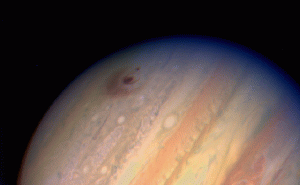
Jupiter has found itself in the spotlight again, this time with news that reports of the demise of its famous Great Red Spot may have been greatly exaggerated, and also that the Solar System’s largest planet may have once again been impacted by a large object that left a bright scar in the Jovian clouds.
On August 7, amateur astronomer Ethan Chappel spotted a bright flash that burst in the clouds of Jupiter’s South Equatorial Belt, on a similar latitude to the Great Red Spot. Jupiter’s massive gravitational field makes it a veritable magnet for asteroids, with at least one to five objects 5 to 20 meters (17 to 65 feet) across hitting it per month, with the most famous event occurring in 1994, when comet Shoemaker-Levy 9 punched through the planet’s cloud tops.
Chappel is still awaiting confirmation from other astronomers, to see if anyone else had spotted the impact. “Today has felt completely unreal to me,” Chappel wrote on Twitter. “Hoping someone else also recorded the impact to seal the deal.”
Further east across the face of the planet, it turns out that the Great Red Spot may not be unraveling after all. Last May, citizen scientist astronomers found that Jupiter’s famed Great Red Spot appeared to be unraveling, a potential sign that the massive storm’s centuries-long decline was accelerating. A large dark streamer that stretched around the planet appeared to be spiraling off of the GRS, with the space between the main body of the storm and the dark band of clouds streaming off of it increasing in width.
The impending loss of the Solar System’s largest storm prompted scientists at NASA’s Outer Planet Atmospheres Legacy program to investigate, analyzing both pictures sent to them by amateur astronomers and high-resolution images captured by the Hubble Space Telescope. But when they conducted a detailed survey of wind speeds in the GRS and surrounding atmosphere, they found that the streamers connected to the Great Red Spot weren’t flowing out of the storm, but rather back in: basically, the storm doesn’t appear to be diminishing any faster than it has over the past few centuries.
“It’s always doing this,” explains Amy Simon, the Outer Planet team lead. The GRS “is always pulling stuff in and parts of it are flying off. That is not unusual at all.” Although the Great Red Spot is definitely changing its shape, its strength would appear to be just as strong as expected.
Part of the illusion that the Great Red Spot is unraveling, according to Simon, is that the material flowing into the storm has taken on a reddish color that is much like the characteristic hue of the Spot itself, giving the impression that this material is bleeding outward into the surrounding clouds—despite Simon’s team tracking the winds as flowing into the storm.
The planet-circling streamers have also changed their behavior, increasing the volume of their flow, and sometimes not even linking directly to the GRS itself. The streamers, at least over the past few months, have oftentimes simply circled the periphery of the storm a number of times before escaping its orbit: typically, the streamers either connect to the GRS, or they pass right through it. As for the increase in the flow of the streamers involved, they have “gone from a two-lane country road…to a six-lane highway,” according to Glenn Orton, a scientist with NASA’s Jet Propulsion Laboratory.
Subscribers, to watch the subscriber version of the video, first log in then click on Dreamland Subscriber-Only Video Podcast link.